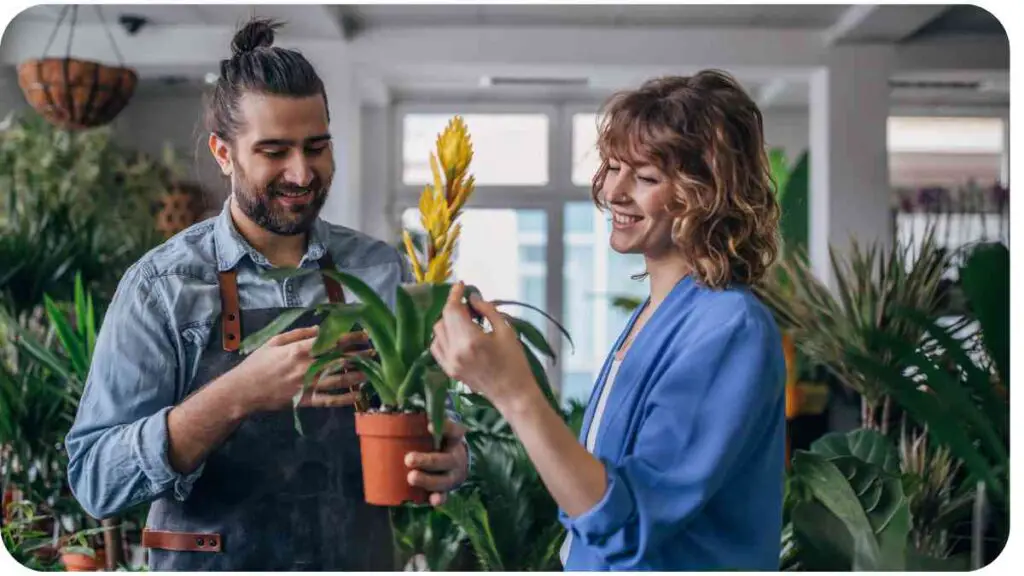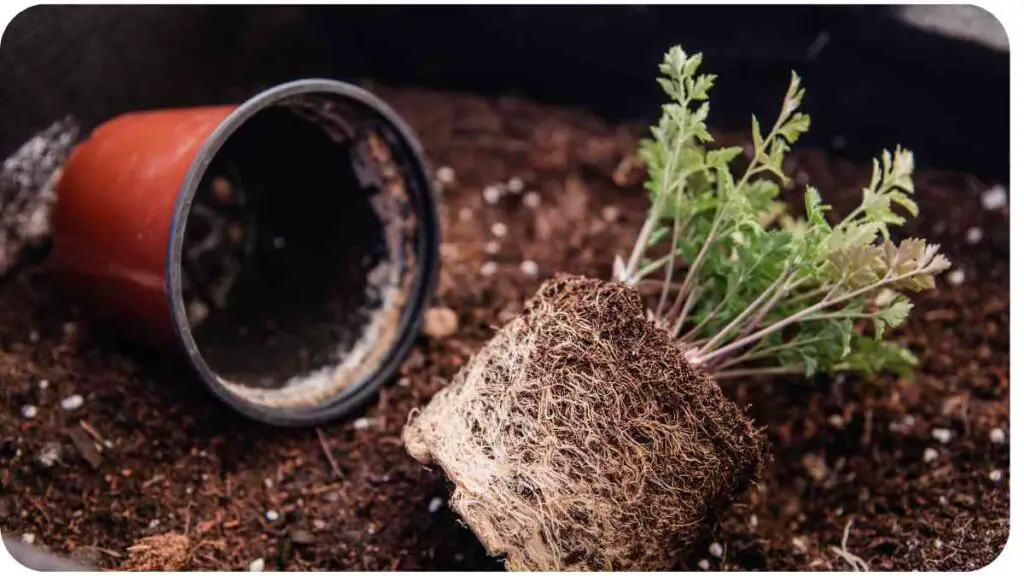Potting a large house plant might seem like a daunting task, but with the right approach, it can be a rewarding experience. Proper potting not only ensures your plant’s health but also enhances its aesthetic appeal in your home. In this guide, we’ll walk you through everything you need to know about potting a large house plant, from choosing the right pot to maintaining your plant’s health.
| Key Takeaway |
|---|
| Choose a pot that fits your plant’s size and drainage needs. |
| Use a well-draining potting mix with peat moss, perlite, and compost. |
| Prepare your plant by trimming damaged roots and leaves. |
| Follow a step-by-step potting process to avoid common mistakes. |
| Water thoroughly after potting and adjust watering based on plant needs. |
| Repot when the plant outgrows its current pot or the soil becomes depleted. |
| Address common issues like root rot and overwatering promptly. |
| Seek expert advice and personal experiences for additional tips. |
Choosing the Right Pot

Factors to Consider
When selecting a pot for your large house plant, there are a few key factors to keep in mind. The pot should be large enough to accommodate the plant’s root system, but not so large that it retains excess moisture, which can lead to root rot. Additionally, consider the pot’s drainage capabilities to ensure that excess water can escape easily.
If you want to make sure your garden thrives, consider using the right herb garden methods for your backyard. Understanding the techniques can help you grow a variety of herbs efficiently.
Pot Sizes and Materials
Choosing the right size and material for your pot is crucial. Here’s a quick guide to help you make an informed choice:
Table: Pot Sizes and Their Suitability
| Pot Size | Suitable For | Material Options |
|---|---|---|
| 12-14 inches | Small to Medium Large Plants | Plastic, Ceramic, Terracotta |
| 16-18 inches | Medium to Large Plants | Ceramic, Terracotta |
| 20+ inches | Very Large Plants | Plastic, Ceramic, Resin |
Selecting the Best Soil
Soil Types for Large Plants
The right soil mix can make a significant difference in your plant’s growth and health. For large house plants, a well-draining soil mix is essential. Look for soil blends that include a mix of peat moss, perlite, and compost to ensure good aeration and nutrient availability.
How to Prepare Potting Mix
To create an ideal potting mix, combine equal parts of peat moss, perlite, and compost. This mixture provides a balance of drainage and nutrient retention. If you’re potting a plant with specific needs, such as succulents or orchids, adjust the mix accordingly.
Creating a backyard oasis requires planning and a thoughtful approach, so you can take inspiration from this list of backyard designs. The right ideas will help you transform your space into a dream escape.
Table: Types of Soil and Their Uses
| Soil Type | Best For | Key Characteristics |
|---|---|---|
| Peat Moss | General Purpose | Moisture retention, acidic |
| Perlite | Well-Draining Mixes | Good aeration, lightweight |
| Compost | Nutrient-Rich Mixes | Rich in nutrients, organic |
Preparing the Plant
Assessing the Plant’s Condition
Before potting, take a close look at your plant. Check for any signs of disease, pests, or root issues. Trim away any damaged or unhealthy roots and leaves to ensure your plant starts off in the best possible condition.
Trimming and Pruning Before Potting
Pruning helps to promote healthy growth and can make the potting process easier. Trim any overgrown or unhealthy roots and leaves, and ensure the plant is well-balanced before moving it to its new pot.
Potting Process
Step-by-Step Guide
Follow these steps to pot your large house plant successfully:
- Prepare the Pot: Ensure the pot has drainage holes. Place a layer of gravel or broken pot shards at the bottom to aid drainage.
- Add Soil: Fill the pot with a layer of your prepared potting mix.
- Position the Plant: Gently place the plant in the center of the pot.
- Fill with Soil: Add more potting mix around the plant, gently pressing down to remove air pockets.
- Water Thoroughly: Water the plant well to settle the soil and ensure proper hydration.
Enhancing the beauty of your backyard might also involve building structures, so you could explore this DIY backyard deck guide to help make the process easier and enjoyable.
Table: Step-by-Step Potting Instructions
| Step | Action | Notes |
|---|---|---|
| Prepare the Pot | Add gravel or shards for drainage | Prevents waterlogging |
| Add Soil | Place a layer of potting mix | Ensures a good base for roots |
| Position the Plant | Center the plant in the pot | Align roots evenly |
| Fill with Soil | Add and press down potting mix | Avoid air pockets |
| Water Thoroughly | Water the plant well | Settles soil and hydrates plant |
Common Mistakes to Avoid
- Choosing the Wrong Pot Size: Avoid pots that are too large or too small for your plant.
- Overwatering: Ensure proper drainage to prevent root rot.
- Skipping Soil Preparation: Use a well-balanced mix for optimal growth.
Watering and Maintenance
How to Water a Newly Potted Plant
After potting, it’s important to water your plant thoroughly. This helps settle the soil and provides essential moisture for the plant’s roots. Monitor the plant’s watering needs based on its environment and growth stage.
Tips for Ongoing Care
- Regularly Check Soil Moisture: Use your finger or a moisture meter to gauge soil dryness.
- Adjust Watering Frequency: Increase or decrease watering based on seasonal changes and plant needs.
Organizing outdoor activities is crucial for making the most of your space. Be sure to check out these fun backyard games ideas for creative and easy ways to have fun with friends.
Repotting Large Plants

When and Why to Repot
Repotting is necessary when your plant outgrows its current pot or if the soil becomes depleted. Signs that it’s time to repot include roots growing through the drainage holes or a noticeable slowdown in growth.
Repotting Tips and Tricks
- Choose a Slightly Larger Pot: This provides room for growth without overwhelming the plant.
- Refresh Soil Mix: Use fresh potting mix to provide new nutrients.
Common Issues and Solutions
Dealing with Root Rot
Root rot can occur if the soil remains too wet. To address this issue, ensure proper drainage and avoid overwatering. If root rot is severe, you may need to trim affected roots and repot the plant in fresh soil.
Addressing Overwatering and Underwatering
- Overwatering: Reduce watering frequency and improve drainage.
- Underwatering: Increase watering frequency and ensure the plant receives adequate moisture.
Table: Common Problems and Solutions
| Issue | Solution | Prevention Tips |
|---|---|---|
| Root Rot | Improve drainage, trim affected roots | Ensure pot has drainage holes |
| Overwatering | Reduce frequency, check drainage | Water only when topsoil is dry |
| Underwatering | Increase frequency, water thoroughly | Monitor soil moisture regularly |
Expert Tips and Tricks
Insights from Professional Gardeners
According to expert gardener Jane Smith, one key to successful potting is selecting the right potting mix for your specific plant type. She advises using a mix with added organic matter to improve moisture retention and nutrient availability.
Keeping your backyard clean and healthy is vital for any space. A great way to begin is by reading these backyard maintenance tips that can help you manage your garden effortlessly.
Personal Anecdotes and Experiences
In my experience, I once struggled with a large fiddle leaf fig that was constantly dropping leaves. It turned out that the pot’s drainage was inadequate, leading to root rot. By switching to a pot with better drainage and using a well-balanced soil mix, the plant thrived and recovered.
Conclusion
Potting a large house plant doesn’t have to be overwhelming. By choosing the right pot, soil, and following proper potting techniques, you can create an ideal environment for your plant to flourish. Remember to monitor your plant’s needs and make adjustments as necessary to ensure its continued health and growth. Happy potting!
Further Reading
For more in-depth information on potting and repotting large house plants, check out these resources:
- The Sill – Plant Care: Repotting
A comprehensive guide from The Sill on why and how to repot plants, including tips on timing and techniques. - Gardening Know How – Repotting a Large Plant
This article provides detailed steps and advice for successfully repotting large houseplants, with practical tips for various plant types. - Hortology – Repotting Houseplants
Hortology’s guide on repotting houseplants covers the essentials of choosing the right pot and soil, as well as common mistakes to avoid.
FAQs
What is the best time to repot a large house plant?
Repot a large house plant during its active growing season, typically in spring or early summer. This allows the plant to recover more quickly and adapt to its new pot.
How do I know if my plant needs repotting?
Signs that your plant needs repotting include roots growing out of the drainage holes, a plant that is top-heavy or leaning, and soil that dries out too quickly.
Can I use regular potting soil for large plants?
While regular potting soil can work, it’s often best to use a mix specifically designed for the type of plant you’re potting. For example, cacti and succulents need a well-draining mix, while tropical plants might need a richer, more moisture-retentive blend.
How do I handle root rot during repotting?
If you notice root rot, trim away the affected roots before repotting. Ensure the new pot has good drainage and use a fresh, well-draining soil mix to prevent future issues.
Should I water the plant immediately after repotting?
Yes, water the plant thoroughly after repotting to help settle the soil and provide moisture to the roots. However, make sure the pot has proper drainage to avoid waterlogging.

For 15 years, Hellen James has worked in the gardening industry as an expert and landscape designer. During her career, she has worked for a variety of businesses that specialize in landscaping and gardening from small firms to large corporations.

